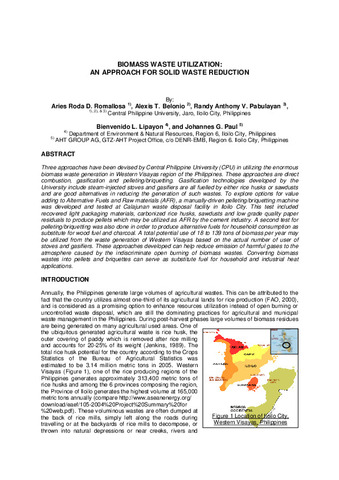Biomass waste utilization: An approach for solid waste reduction
| dc.contributor.author | Romallosa, Aries Roda D. | |
| dc.contributor.author | Belonio, Alexis T. | |
| dc.contributor.author | Pabulayan, Randy Anthony V. | |
| dc.contributor.author | Lipayon, Bienvenido L. | |
| dc.contributor.author | Paul, Johannes G. | |
| dc.date.accessioned | 2022-02-07T02:48:24Z | |
| dc.date.available | 2022-02-07T02:48:24Z | |
| dc.date.issued | 2009-11 | |
| dc.identifier.citation | Romallosa, A. R. D. , Belonio, A. T. , Pabulayan, R. A. V. , Lipayon, B. L. & Paul, J. G. (2009). Biomass waste utilization: An approach for solid waste reduction. International Conference on Solid Waste Management: Wastesafe 2009. | en_US |
| dc.identifier.uri | https://hdl.handle.net/20.500.12852/1915 | |
| dc.description | Conference paper | en_US |
| dc.description.abstract | Three approaches have been devised by Central Philippine University (CPU) in utilizing the enormous biomass waste generation in Western Visayas region of the Philippines. These approaches are direct combustion, gasification and pelleting/briquetting. Gasification technologies developed by the University include steam-injected stoves and gasifiers are all fuelled by either rice husks or sawdusts and are good alternatives in reducing the generation of such wastes. To explore options for value adding to Alternative Fuels and Raw materials (AFR), a manually-driven pelleting/briquetting machine was developed and tested at Calajunan waste disposal facility in Iloilo City. This test included recovered light packaging materials, carbonized rice husks, sawdusts and low grade quality paper residuals to produce pellets which may be utilized as AFR by the cement industry. A second test for pelleting/briquetting was also done in order to produce alternative fuels for household consumption as substitute for wood fuel and charcoal. A total potential use of 18 to 139 tons of biomass per year may be utilized from the waste generation of Western Visayas based on the actual number of user of stoves and gasifiers. These approaches developed can help reduce emission of harmful gases to the atmosphere caused by the indiscriminate open burning of biomass wastes. Converting biomass wastes into pellets and briquettes can serve as substitute fuel for household and industrial heat applications. | en_US |
| dc.language.iso | en | en_US |
| dc.subject.lcsh | Biomass | en_US |
| dc.subject.lcsh | Biomass energy | en_US |
| dc.subject.lcsh | Refuse and refuse disposal | en_US |
| dc.subject.lcsh | Integrated solid waste management | en_US |
| dc.subject.lcsh | Briquets (Fuel) | en_US |
| dc.subject.lcsh | Philippines--Western Visayas | en_US |
| dc.subject.lcsh | Briquets | en_US |
| dc.subject.lcsh | Recycling (Waste, etc.) | en_US |
| dc.title | Biomass waste utilization: An approach for solid waste reduction | en_US |
| dc.type | Conference paper | en_US |
| dcterms.accessRights | Publicly accessible | en_US |
| dc.citation.firstpage | 1 | en_US |
| dc.citation.conferencetitle | International Conference on Solid Waste Management: Wastesafe 2009 | en_US |
이 항목의 파일
This item appears in the following Collection(s)
-
Conference papers [17]


